Monolithic to Microservices Migration Assessment
Publish Date: July 21, 2022Point of View for your potentially difficult, but worthwhile, migration journey
The emergence of microservices architecture has been on the rise in recent times. It promises faster time to market, business agility and flexibility. Moreover, due to advances in cloud technology, the demand for microservices is increasing even more in scale. As the monolithic to microservices migration rate continues to increase, the question of whether or not it is better to stick to the traditional monolith or opt for microservices is becoming progressively relevant. The fact that microservices are projected to grow globally at an impressive 22.5% rate by 2025 means that this decision is even more important than ever, since it can have a profound impact on how your organization develops, scales and operates over the next few years.
Despite its name, a monolith isn’t an outdated architecture and has its benefits. Also, organizations have to consider the cost and complexity of migrating legacy applications to microservices, and hence the decision to migrate monolithic to microservices should be based on a careful evaluation and assessment process.
We briefly compare monolithic and microservices architecture with their pros and cons and provide a comprehensive list of the factors an organization should consider while assessing the migration of their monolithic applications to microservices.
Architectural difference between Monolithic and Microservices:
A microservice architecture is a software architecture design that divides a large application into multiple loosely coupled components, which are deployed and managed independently. This can be explained as follows: Monolithic applications provide relatively low levels of granularity by aggregating functionality into a single code base. Microservices, on the other hand, distribute application functionality into independent services that communicate across the network via well-defined interfaces and independent of each other. A few key principles of microservices are Scalability, Availability, Resiliency, Failure Isolation, Auto-Provisioning, Easy Governance, and Continuous Delivery through DevOps. Here’s how the architectures differ:
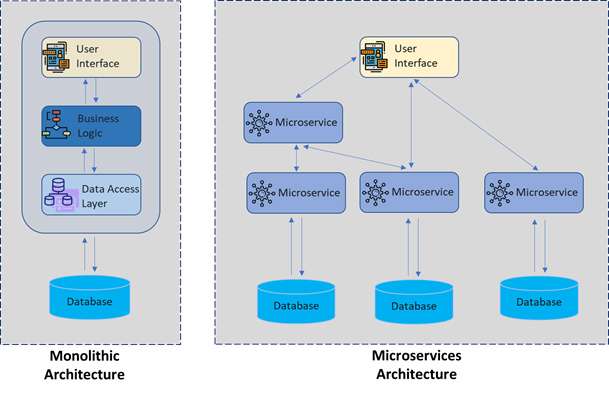
Having established the high-level difference between Monolithic and Microservices architecture, we now delve deeper into each architecture’s pros and cons.
Pros & Cons of Monolithic Apps:
| PROS | CONS |
|---|---|
| Simplicity: Simple to build, debug, test and deploy when application is small.
Techstack: Mostly built on single technology hence resource with single technology knowledge can build and manage. Performance: Performance advantage as inter process communication is not required. Ease of use: Monolithic software applications have many different functionalities contained within a single application, including logging, caching, security. This makes it easier to handle in single place. |
Scalability: Monolithic application are not easy to scale up/down.
Reliability: An error in any of the components in the application can bring the entire application down. Coupling: Monolithic app components are tightly coupled, making it difficult to isolate components for purposes such as independent scaling or code maintainability. Maintainability: As an application grows, Monolithic applications becomes hard to understand and manage. Updates: Due to a single large codebase and tight coupling, the entire application needs to be tested and deployed on each update. |
Microservices advantages and benefits: A microservices approach encapsulates each business capability into individual services. Every application process function as a separate, loosely coupled service with its logic and database. Updates, testing, deployment, and scaling happen within the scope of each service. While microservices don’t reduce the complexity of a system, they do make complexity more visible and manageable. Here are some of the advantages and benefits of microservices.
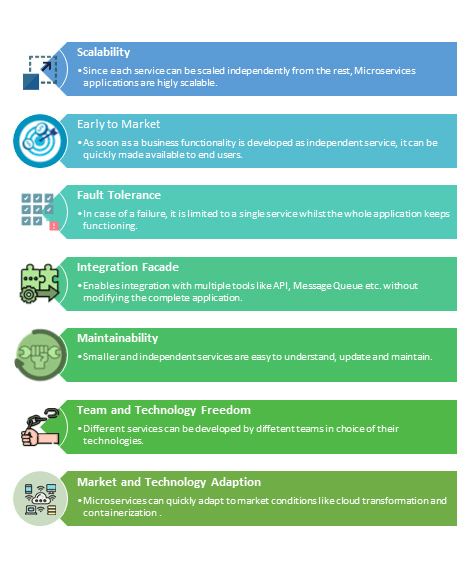
When considering a potential microservice project, you need to weigh both the advantages and risks of migrating to a microservices architecture. While many benefits result from microservices, there are also drawbacks. Microservices can help improve agility and enable a nimbler development process, but they require better latency in order to ensure high-performance. However, despite some of the cons, a microservices architecture allows you to manage growing data, take advantage of advance cloud and automation capabilities and accelerate the deployment of solutions.
A successful migration to microservices depends on understanding your organization’s needs and how these benefit from microservices. By identifying the areas where microservices may improve the business value proposition, you can make more informed decisions about whether an organization should consider transitioning to a more distributed architecture or not.
The answer is a careful and detailed assessment of their existing monolithic applications. The assessment should help the organizations to evaluate all possible trade-offs and decide if they should migrate their monolithic applications to microservices.
There are many strategies, frameworks, and app modernization tools that can help organizations in their migration journey but there is a serious dearth of frameworks or tools which can help organizations assess and decide if they should migrate their monolithic applications to microservices.
Ideally, the migration assessment should help the organizations get visibility in at least the following three areas which can help them in taking the migration decision.
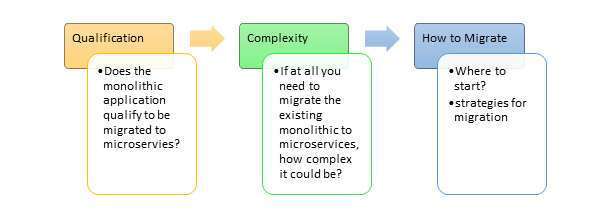
The qualification and complexity are relatively easy to assess, but the actual migration is certainly not an easy task. However, with a detailed discovery, assessment, and analysis of existing monolith systems and by choosing the right approach, patterns, and tools for migration, organizations can confidently migrate their monolithic application to microservice with lesser risks.
The migration assessment framework should consider multiple factors which can directly or indirectly influence the migration decision. Broadly, but not limited to, the assessment should consider factors like:
- The current state of the application and its fitness for present and future need
- The organization’s readiness for migration
- Availability of supporting tools and technology
- The state of current architecture
- Security, and compliance related requirements
- Functional complexity and ease of migration
- DevOps maturity
As each these factors influence the migration decision differently the framework should consider the differential weightage for different factor to rationalize the overall assessment outcome.
At YASH Technologies, we have developed an Assessment Decision Framework to help organizations in their decision-making for their journey from Monolithic to Microservice Migration. The framework consists of a different set of questionnaires relevant to the migration scenario covering the factors which influence the migration. The framework has a built-in algorithm that considers different factors and their weights to calculate the overall assessment score and provide qualification and complexity assessment results.
A few capabilities and snapshots of this Assessment Decision Framework are:
1. Easy access: Access the framework either by creating an account or by your exiting Google or LinkedIn account.

2. Qualification Assessment: Perform the Qualification Assessment to know if your monolithic application is qualified to be migrated to microservices-based architecture.
The questions in the qualification assessment are designed to cover all aspects of application migration.
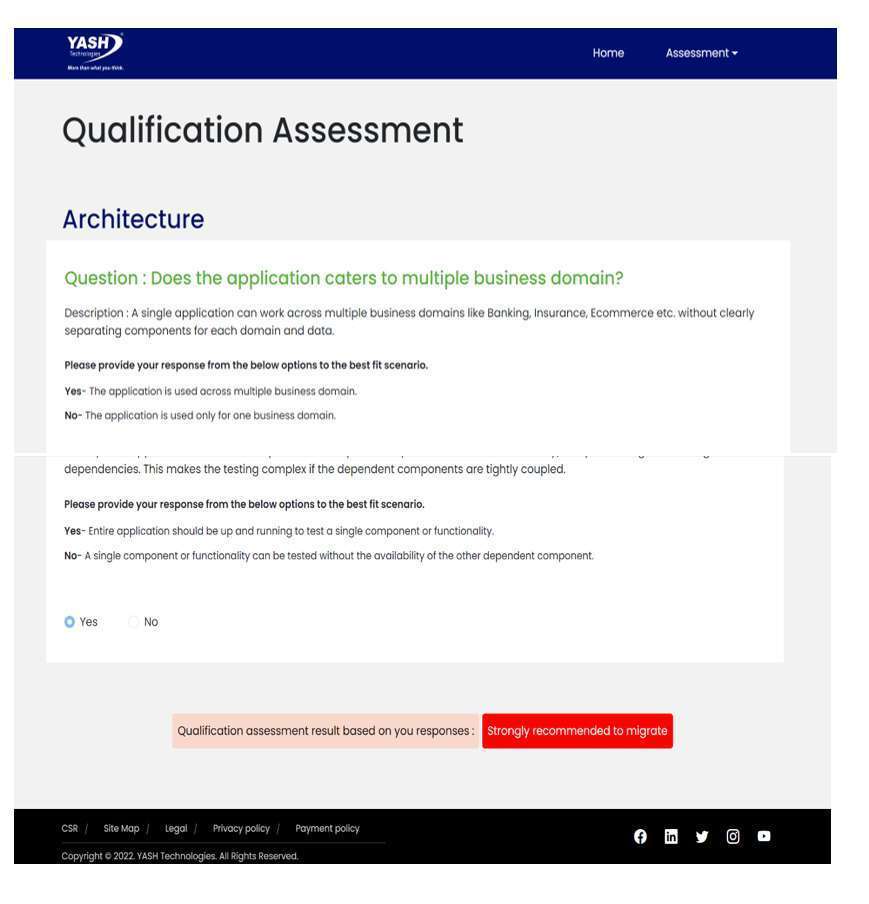
The result of this assessment can be downloaded for reference purposes.
3. Complexity Assessment: Perform the Complexity Assessment to know how complex it could be to migrate your application to microservices-based architecture. The questions in complexity assessment are designed to cover all aspects of application complexity.
The framework analyses the response and generates a complexity Radar chart with complexity scores for different categories and provides overall migration complexity. It also lets you know where your application stands in comparison to the industry average complexity. The complexity report can be downloaded for future reference.
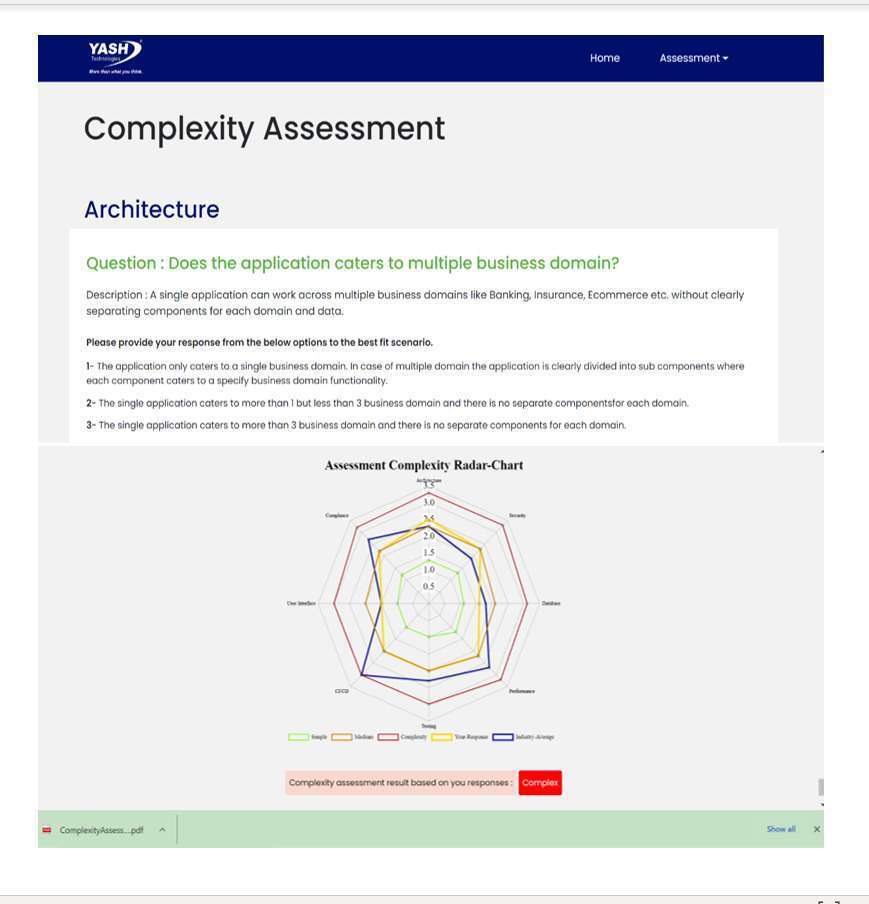
To go or not to go for a microservices architecture may sound like a no-brainer, but the considerations are far more critical and need a microservices expert with an understanding of monolithic architecture and the ability to deeply study and forecast a company’s current and future need, if at all to migrate





